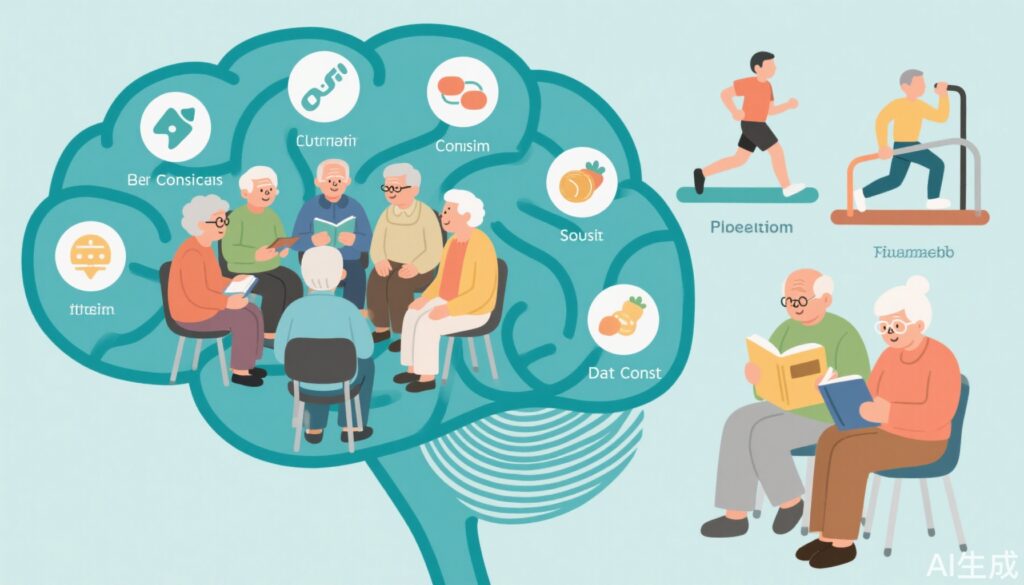Highlights
- Structured, multidomain lifestyle interventions produced greater improvements in global cognitive function versus self-guided interventions over two years.
- Benefits were most pronounced in individuals with lower baseline cognitive function and were consistent across APOE ε4 status, sex, and age.
- Both interventions were safe, though the structured group reported fewer serious and nonserious adverse events.
- Long-term durability and clinical significance of the cognitive benefits remain to be established.
Background
Dementia and age-related cognitive decline pose significant public health challenges, with rising prevalence and substantial impact on patients, families, and healthcare systems. Despite advances, pharmacological treatments for dementia remain limited in efficacy and accessibility. Nonpharmacological strategies targeting modifiable risk factors—such as physical inactivity, unhealthy diet, and poor cardiovascular health—offer promise as safe, scalable, and potentially effective means to delay or prevent cognitive decline. The US POINTER trial was designed to assess whether a structured, intensive multidomain lifestyle intervention could more effectively slow cognitive decline compared to a less intensive, self-guided approach among older adults at elevated risk.
Study Overview and Methodological Design
The US POINTER trial (NCT03688126) is a single-blind, multicenter randomized clinical trial conducted at five US sites between May 2019 and March 2023. A total of 2,111 participants aged 60-79 years, with a sedentary lifestyle, suboptimal diet, and at least two additional risk factors (family history of memory impairment, cardiometabolic risk, race/ethnicity, older age, sex) were enrolled. Participants were randomized in equal numbers to either a structured intervention (n=1,056) or a self-guided intervention (n=1,055), both lasting two years.
Both interventions aimed to improve physical activity, cognitive engagement, diet, social interaction, and cardiovascular health monitoring. The structured group received regular, supervised group sessions, personalized coaching, and systematic follow-up, while the self-guided group was given educational materials and instructions for independent implementation.
The primary endpoint was the annual rate of change in global cognitive function, measured as a composite of executive function, episodic memory, and processing speed, over two years. Secondary analyses explored individual cognitive domains and subgroup effects.
Key Findings
Of the 2,111 enrolled participants (mean age 68.2 years; 68.9% female), 89% completed the two-year assessment. The structured intervention group demonstrated a statistically significant greater annual improvement in global cognition compared with the self-guided group (difference: 0.029 SD per year; 95% CI, 0.008-0.050; P=0.008). Executive function showed the largest benefit (0.037 SD per year; 95% CI, 0.010-0.064), with a trend toward improved processing speed that did not reach significance. Episodic memory gains were similar between groups.
Mean changes from baseline for the global cognitive function composite score fitted using linear contrasts from a mixed-effects model for repeated measures including all available participant data. Global cognitive function composite z scores are scaled to have SD = 1, so nearly 70% of participants obtain a score within 1 SD of the mean. Higher values indicate improved performance relative to baseline. Whiskers indicate 95% CIs. Included are results from the per-protocol analysis to compare slopes (SDs per year) between groups after adjustment for clinical site, baseline age, practice effects, and test version. Mean rate of change over time per year (slope): structured group, 0.243 SD (95% CI, 0.227-0.258); self-guided group, 0.213 SD (95% CI, 0.198-0.229).
Subgroup analyses indicated that the benefit of structured intervention was consistent across APOE ε4 carrier status (P=0.95 for interaction), sex (P=0.44), age (P=0.41), and baseline cardiovascular health (P=0.54). Notably, the benefit was more pronounced among participants with lower baseline cognitive function (0.054 SD per year; 95% CI, 0.024-0.084; P=0.02 for interaction).
Safety outcomes favored the structured group, which had fewer serious (151 vs. 190; P=0.03) and nonserious (1,091 vs. 1,225; P=0.005) adverse events. COVID-19 was the most common event overall, occurring more frequently in the structured group, likely due to increased testing and monitoring.
Clinical Implications
For clinicians and health systems, these findings reinforce the value of structured, high-intensity lifestyle interventions for older adults at risk of cognitive decline. Such programs, when feasible, may produce greater cognitive benefit than self-guided strategies. However, both approaches appear generally safe and well-tolerated. Implementation should consider patient baseline cognitive status, motivation, and available resources. The absence of a true no-intervention group suggests that even self-guided, multidomain approaches may be preferable to usual care.
Limitations and Controversies
The trial’s generalizability is limited by the select, higher-risk study population and by being conducted at only five US sites. The study was not powered to assess dementia incidence or long-term functional outcomes. The self-guided group does not represent a true control, and participants were aware of their group assignment, possibly introducing performance or reporting bias. Durability and scalability—crucial for population-level impact—remain unproven. Additionally, the magnitude of cognitive improvement, though statistically significant, is modest, and its clinical significance for daily function requires further exploration.
Expert Commentary or Guideline Positioning
Current guidelines from organizations such as the Alzheimer’s Association and the WHO endorse multidomain risk reduction strategies for cognitive health, though evidence for optimal format and delivery is evolving. Experts emphasize that while structured support may maximize gains, pragmatic considerations—including cost, accessibility, and patient preference—should guide real-world implementation.
Conclusion
The US POINTER trial demonstrates that structured, high-intensity multidomain lifestyle interventions can yield greater cognitive benefits than self-guided approaches in older adults at risk for cognitive decline. While promising, these results underscore the need for further research into long-term outcomes, implementation strategies, and the mechanisms underlying cognitive resilience. Ongoing follow-up and biomarker studies will be vital to defining the clinical and public health significance of these findings.
References
Baker LD, Espeland MA, Whitmer RA, Snyder HM, Leng X, Lovato L, Papp KV, Yu M, Kivipelto M, Alexander AS, et al. Structured vs Self-Guided Multidomain Lifestyle Interventions for Global Cognitive Function: The US POINTER Randomized Clinical Trial. JAMA. 2025 Jul 28:e2512923. doi:10.1001/jama.2025.12923 IF: 55.0 Q1 .
Livingston G, et al. Dementia prevention, intervention, and care: 2020 report of the Lancet Commission. Lancet. 2020;396(10248):413-446.
Ngandu T, et al. A 2 year multidomain intervention of diet, exercise, cognitive training, and vascular risk monitoring versus control to prevent cognitive decline in at-risk elderly people (FINGER): a randomised controlled trial. Lancet. 2015;385(9984):2255-2263.




